Asus Eee Slate EP121
06:30
Slate
design Windows tablets are few and far between these days. Those that
are available tend to be expensive vertical market solutions or
under-powered and under-sized models from small makers. Asus has entered
the market with the game changing Eee Slate EP121, a 12.1” Windows
tablet with high end specs generally seen only on expensive verticals at
a price that’s consumer-friendly. You’d think Asus has a slam-dunk
since the market for a capable Windows slate tablet offers little
competition; but the bigger problem is Windows’ somewhat unearned
reputation for being a poor tablet platform. Though there’s some merit
to these complaints, many dings rise out of ignorance: the platform has
been around for 10 years and many reviewers dismiss Windows 7 tablets
based on dated experiences. It hasn’t helped that several small
manufacturers (generally Asian companies whose products arrive here
online or through importers) went with underpowered Intel Atom CPUs and
screens that are too small to work well with Windows.
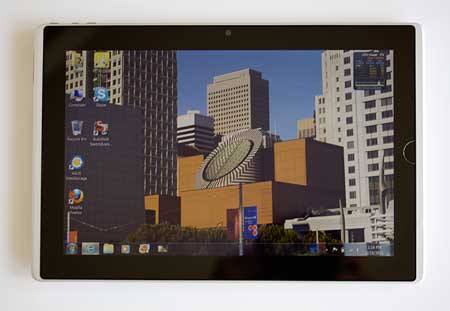
The Eee Slate uses a 12.1”, 1280 x 800
pixel display; the sweet spot for Windows tablets and the most common
size for mainstream convertibles like the HP TouchSmart TM2 and the Lenovo ThinkPad X201t.
It runs on a ULV Intel Core i5 CPU for plenty of processing power and
ships in 2 gig/32 gig SSD and 4 gig/64 gig SSD versions. The display
handles both capacitive multi-touch with 2 touch points, and it has a
Wacom digitizer with EMR pen for note-takers and artists. It runs
Windows 7 Home Premium 64 bit and performance is better than the capable
Lenovo IdeaPad U260 12.5” notebook and worlds better than Intel Atom
and AMD Fusion ultraportables (Fusion does have a gaming advantage
though). Asus likes to bundle accessories in the box, a rare treat these
days, and the Eee Slate comes with a leather portfolio case that can
act as a stand and an Asus-branded Microsoft 6000 portable Bluetooth
keyboard that’s received solid reviews of its own. The leather case’s
functionality as a protective device and stand are very good but we
weren’t terribly impressed with the uneven bonding of the leather to the
semi-rigid inner backing material (there are ripples in the surface).
The keyboard is excellent: it’s compact with a gentle curve for better
typing ergonomics. Since it’s wireless Bluetooth, you can set the Eee
Slate on a tablet in front of you, and use the keyboard in your lap
(excellent for us couch potatoes).
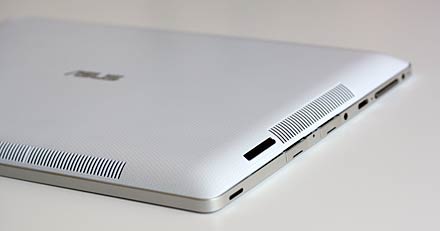
The Eee Slate weighs 2.5 lbs. vs. 1.5
lbs. for mobile OS tablets and its battery life is shorter at 3 to 3.5
hours. Though it runs a full Intel CPU with all the usual PC parts
inside, the 2 fans are quiet and the machine stays uncannily cool, even
when streaming Hulu or Netflix over HDMI to an HD TV. The Slate has 2
USB ports, Atheros WiFi 802.11b/g/n, Bluetooth 3.0 and a mini-HDMI port.
There is no wired Ethernet port, and that means you’ll need a USB
Ethernet adapter if you use a wired network connection.
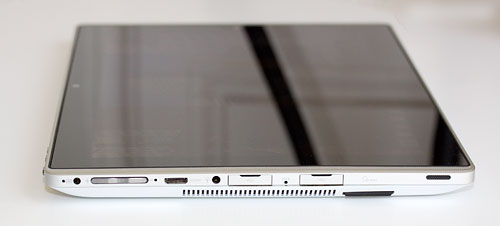 |
The design is elegant with the large
glass dominating the front and an aluminum frame surrounding the slate.
Torsional rigidity is excellent and the tablet doesn’t flex. The back is
white textured plastic and looks nice enough, though not as classy as
the front. Ports and controls are well machined, and there are volume
controls, an on-screen keyboard trigger, anti-rotation lock and power
slider on the sides. All ports are located on the left side, and the two
USB ports are under plastic covers that look nice but require a
fingernail to open easily. The machine has both charging and power
status (on/off/sleeping) LED indicators on the side and top. There’s a
large button on the front face, and a short press runs Aero Peek (shows
all your running apps in staggered stacked card style windows) and a
long press sends Ctrl-Alt-Del.
The front-facing stereo speakers are
surprisingly loud and full sounding by tablet and ultraportable
standards. We enjoyed watching and listening to Hulu, Netflix and ripped
video thanks to the good speakers and sharp, bright and colorful
display. The 2 megapixel webcam lives above the display (when held in
landscape mode), and yielded better Skype video quality than we've seen
on many laptops. It's not much for still shots, however.
Who is the Eee Slate for? It’s for
artists who use the Wacom pen and pressure-sensitive digitizer to work
in Photoshop, Corel Painter, Alias Sketchbook and the included Art Rage
application. It’s for note-takers who prefer the pen to the keyboard,
students (especially Engineering and math students who use symbols and
equations that are hard to enter via keyboard) and workers who need to
work with forms, draw diagrams and the like. Given Asus’ attempt to
consumerize the tablet, it’s also for those who want a tablet but want
or need to do more than mobile OS tablets like the iPad 2 and Android tablets like the Motorola Xoom or Samsung Galaxy Tab can do. If you’re sick of not having Adobe Flash or dealing with its
lackluster performance on some Android devices, if you want to do it
all, from MS Office to Adobe Creative Suite CS5 to iTunes, Netflix and
Hulu, the Eee Slate is worth a look. Since it’s Windows 7, the Eee can
do anything a PC can do, and you’re not tied to an app store or market
to get apps. The drawback? Since it’s Windows you must deal with Windows
updates and anti-virus software. And not all UI elements are designed
for easy touch operation.
Display and Digitizer
In a word: “wow”. The Slate’s 12.1” AFFS
(advanced fringe field switching) display by Boe Hydis is simply
fantastic. The technology is similar to IPS (used in the iPad and
offered as an option on some Lenovo ThinkPads). Like IPS it’s very
bright and has wide viewing angles (up to 178 degrees). The display is
extremely sharp and clear and colors are accurate with relatively little
shift and fade at extended viewing angles. It’s so bright that I rarely
use it above 50% indoors (it averages 282 nits) and contrast is quite
high. Unlike the iPad that tends to fade terribly outdoors, the Eee
Slate is readable and usable outdoors—a big plus for vertical users who
work outdoors and outdoor sketch artists. Its sharpness and viewing
angles put the otherwise capable HP TM2 to shame (the TM2 has lousy
viewing angles) and its clarity and colors beat Fujitsu convertible
tablets like the T5000 series and T900. If you’re an artist, you’ll love
this display for its brightness, good colors and wide viewing
angles—other than the glare from the gloss Gorilla Glass surface, it’s
near perfection. Thanks to the Eee’s much better display and much
lighter weight, I’ve decided to replace my HP TM2. That said, if you
need a keyboard most of the time and carry the tablet with you to
classes, work or other places, the TM2 can still make sense.
 |
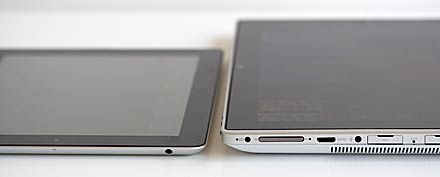
Asus Eee Slate vs. iPad 2 size comparisons.
|
You can use your finger to interact with
Windows and applications, and the OS and Microsoft apps are touch
aware. That means you can scroll pages and pinch zoom just as you would
on mobile touch OS device (see our video, above). Microsoft’s Touch
Pack for Windows 7 is pre-installed and it includes finger-optimized
apps like Microsoft Surface Globe, Rebound and MS Surface Collage. For
non-Microsoft apps that aren’t touch aware, you’ll need to use the
scroll bars (we suggest you follow our tweak and enlarge them) and you
might not get finger-panning and scrolling. We assume Asus has used a
fingerprint-resistant coating on the display since it stays fairly clean
and is easy to wipe off.
The buttonless Wacom tablet PC pen lives
in a spring-loaded silo up top under a door (open the door and the
stylus pops up). After calibration, pen accuracy is on par with other
Windows tablets on the market, and it supports pressure sensitivity.
However, like most all tablet PCs, the Wacom Wintab driver for pressure
sensitivity in Photoshop isn’t pre-installed (you do get pressure
sensitivity in the included Art Rage app and others that don’t depend on
WinTab). There are a variety of drivers you can use to get pressure
sensitivity in Photoshop, including Wacom’s own tablet PC drivers.
Horsepower and Temperatures
The Eee Slate runs on Intel’s ULV
(ultra-low voltage) Core i5 470UM CPU clocked at 1.33GHz with Turbo
Boost to 1.86GHz. It has 2 cores and 4 threads with 3MB cache. This
32nm CPU was just launched in Q4 of 2010, and it’s the latest and
greatest for ultra-portable Intel CPUs (we’re only now seeing Sandy
Bridge ULVs). It can address up to 8 gigs of DDR3-800 RAM, though
there’s only 1 SODIMM slot, and 4 gig sticks are the largest available
on the market. The machine has Intel HD integrated graphics that can
clock up to 500MHz. It’s not nearly as impressive as Intel’s HD3000
graphics used in Sandy Bridge, and as a result this is no 3D gaming rig
(trust us, we tried). Intel’s HD graphics are more than adequate for
1080 video playback, casual games, Photoshop, a variety of art programs
and some light video editing. We had no trouble streaming 1080p video
via the mini-HDMI port to our big screen HD TV. Photoshop CS5 runs
smoothly (see our video above), and even heavy filters executed with
good speed.
Windows Experience Index:
Processor: 5.5
Memory (RAM): 5.5
Graphics (Aero): 3.2
Graphics (3D): 3.4
Hard disk: 5.9
Memory (RAM): 5.5
Graphics (Aero): 3.2
Graphics (3D): 3.4
Hard disk: 5.9
PCMark Vantage Benchmarks:
PCMark: 4489 PCMarks
Memories: 2311
TV and Movies: 2220
Gaming: 3863
Music: 5650
Communications: 2405
Productivity: 6415
HDD: 7201
Memories: 2311
TV and Movies: 2220
Gaming: 3863
Music: 5650
Communications: 2405
Productivity: 6415
HDD: 7201
The Eee Slate uses the new mSATA SSD
drive design, and that drive looks like a mini-PCI card. This is not a
2.5” standard notebook hard drive form factor, and there’s no room for a
standard drive. Asus offers the Slate in 32 and 64 gig configurations,
and for the extra $100 we heartily recommend the 64 gig model that also
increases RAM from 2 to 4 gigs: the price is reasonable for these
upgrades and it’s hard to get by with only 32 gigs of storage. The SSD
drive is made by Sandisk, and if you wish to upgrade capacity (and speed
by a little bit), the 80 gig Intel 310 SSD is a good choice for $200.
The tablet has an SD card slot, and it’s handy for storing movies, large
images and other documents but you wouldn’t want to install programs on
a card because the SD card interface is too slow.
We’re impressed at how cool the Eee
Slate runs: it remains completely comfortable to hold in the crook of
your arm even when plugged in. With moderate use, the back temperatures
range from 74 to 78 degrees Fahrenheit, and when playing Hulu for an
hour, the back got no hotter than 86 degrees. Remarkable. The CPU isn’t
chronically underclocked by default either; it manages to run this cool
at full speed.
Inside the Eee PC Slate: Opening it Up
How do you break into the Asus to
upgrade components? There are no screws or obvious points of entry since
Asus didn’t design it to be opened by novices. To remove the white
plastic back cover, you’ll need to pry it off, starting at the USB port
area. Use a credit card or spludger tool continue working around the
edges to pry off the back. It’s actually not that hard, but do watch out
for the ribbon cable that runs from the motherboard to the back cover.
Once you have the back off, you can access the single RAM slot (it takes
standard DDR3 10666 RAM), the mini PCI network card, and mSATA SSD
drive under a copper RF-shield film. To replace it, simply snap it back
on by pressing on the edges where it joins the aluminum frame.
Battery Life and Charger
The 34W/hr Lithium Polymer battery is
sealed inside the Eee Slate, so you can’t swap batteries for a long day
in the field away from an outlet. Asus claims the EP121 can run for up
to 4.5 hours, but with brightness set to 50% and both WiFi and Bluetooth
on, we average 3 to 3.5 hours on a charge. The Slate can play a 2 hour
HD movie on a charge, but not much more. In terms of battery life,
Windows tablets can’t compete with mobile OS tablets like the iPad 2.
Asus could have used a larger battery (the battery actually consumes a
good deal of the inner cavity), but that would mean a larger and heavier
tablet. Likewise, they could have used a low power Intel Atom CPU, but
performance would have tanked, making the Eee not much better than other
underpowered competitors.
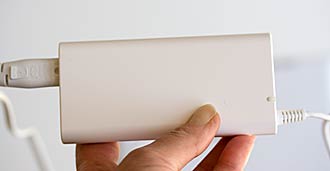
The compact white charger is easy to carry and pack and we love the USB charging port that’s built-in.


0 comments